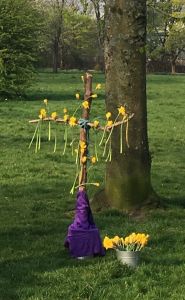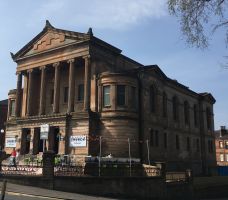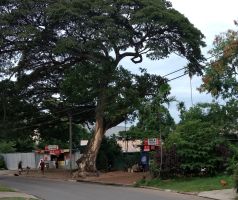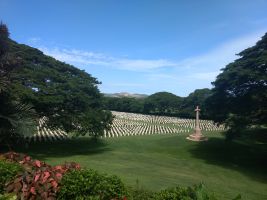Spring 2019
| From the Minister
Impressions of Papua New Guinea (1, 2019) |
Welcome to our parish newsletter! We are pleased to introduce a new member of the production team: Rosemary Wearing, who has kindly agreed to be our sub-editor and all that entails. And thanks, as always, to Rod for the high standard of production.
In the last newsletter, we concentrated on the many things happening within our Church. In this edition, Tim’s regular report for the Church Council keeps us up to date with current projects; but, otherwise, we look beyond, to the wider world. First, Craig’s words to us have a particular meaning in this context. From the Minister Spring is suddenly in the air, bringing with it anticipation of brighter days, even if winter has not yet quite let go its hold. We have finished the best part of three months of Sunday considerations of Hosea, a voice from another world but there is certainly a good deal of autumn and winter in the prophets, as we find also around ourselves. In that overcast world, Hosea spoke of grace and judgement and grace, and the form of life which properly responds to that word – the responsible life of the believer. This has, of course, been complemented by our soon-to-finish series on the Ten Commandments – also a call to respond to the God who ‘brought you out of Egypt’. In the next couple of months we’ll turn Paul’s first letter to Timothy. This text differs enormously from those of the strident prophets. Yet the writer of the letter is no less strident, even if the context is less dramatic than the intrigues of eighth century Israel. 1 Timothy addresses more directly the shape of the responsible life as it manifests in us as individuals, calling us to rise in our personal lives to the height of our calling. The letter is not without its challenges to modern readers but it is only a challenge which has the capacity to move us into a deeper and richer understanding of ourselves and vision of God. To rise to this challenge is to enter into spring as the time of life’s burgeoning in preparation for the full glory of summer’s Son. The love of mercy and the knowledge of God, Hosea says. A pure heart, a good conscience, sincere faith, Paul writes to Timothy. Let such things as these be the blooms which colour our lives in the yet grey world. Church Council News Dinners for Eight Church Councillors are looking at further ways of bringing members of the Congregation together in conversation, discussion, fellowship and friendship beside what is offered already. Have you any suggestions to make? Book study of ‘Life Together’ Elders’ pastoral lists Annual election of office-bearers at Church Council Comments, queries and suggestions are invited by the Church Council: Gaye Champion (Chair, Hotham Mission), Benita Champion (Elder), Andrew Gador-Whyte (Elder), Gus MacAulay (Elder), Rod Mummery (Elder and Treasurer), Tim O’Connor (Elder and Chair), David Radcliffe (Elder), Craig Thompson (Minister) and Alan Wilkinson (MTEFP Coordinator). Our first story presents a very different picture of Glasgow from that of a “gritty, industrial city from the Victorian Era”, which may be our view from so far away. Easter in Glasgow In April, Vicki and I visited our daughter, her partner and most importantly our grand-daughter in Glasgow. Now rapidly approaching her second birthday, we had not seen Judith since she was just a few weeks old. Our trip was timed to ensure that we were back in Melbourne in time for the birth of our third grandchild, due in early May. However this meant we would be away from Mark the Evangelist during Easter. Sarah moved to the UK in 2007 to undertake her Master’s degree at York University; simultaneously we moved from Brisbane to the USA. A few years earlier, our son Dylan had moved to a job in Melbourne. After time also studying in Budapest and then working in London, Sarah and Alex bought a house in Glasgow and moved there in 2016. The strange thing is that we lived in Glasgow between 1974-78 while I was working on my PhD. So we always enjoy revisiting Glasgow as it was a very formative time early in our married life. While Glasgow conjures up images of a gritty, industrial city from the Victorian era, in fact settlements by the Clyde go back at least to Roman times. Glasgow as such was founded around 540 by Saint Kentigern, better known as St Mungo, a missionary who planted a church community there. The name has Gaelic origins and depending which scholar you choose, it derives either from “Glas-cu” (beloved green place – where the first church was erected) or “Cleschu” (dear family). Either way refers to the Christian community St Mungo nurtured there. The present-day Glasgow Cathedral, originally Roman Catholic but now Church of Scotland is built on the site of the first church and St Mungo is buried in the crypt beneath it. January 13 is the feast day of this patron saint of Glasgow.
The symbols depicted on the crest are described in the following verse. The bird that never flew refers to a wild robin tamed by St Serf but accidentally killed by some of his disciples who blamed it on Mungo. He took the dead bird in his hands and prayed, restoring it to life, whereupon it flew to its master. The legend has it the bell that never rang was given to St Mungo by the Pope. Whatever the veracity of this there is a long history of handbells in Glasgow’s ecclesiastical history mostly associated with remembering the souls of those who have departed. As a boy in the monastery Mungo was left in charge of the holy fire in the refectory. He fell asleep and some of the other boys, being envious of him, put out the fire. When he awoke and found what had happened, Mungo broke off some frozen branches from a hazel tree and caused them to burst into flames by praying over them. Hence the tree that never grew. The fish that never swam, is a salmon and a ring in its mouth. Hydeck Hael, King of Cadzow accused his Queen, Languoreth, of infidelity and demanded to see her ring, threatening execution if she could not produce it. The king had thrown the ring in the Clyde. The Queen appealed to or confessed to St Mungo depending which version of the story you believe. He sent one of his monks to fish in the river, instructing him to bring back the first fish caught. This was done and St Mungo extracted the ring from its mouth. While Christianity gave rise to the city, Easter in Glasgow today is more about enjoying the Bank Holiday long weekend. It was exemplified for us by the line of people taking selfies next to the giant bunny at the entrance to the swanky shopping mall in Buchanan Street.
It was a glorious spring morning, a bit nippy at first but with the promise of sunshine. Of course Easter celebrations in the northern hemisphere take place in the context of abundant new life with birds tweeting, bulbs blooming and trees budding. This simple outdoor service was conducted in a green park by a running burn (creek) attended by around 25 parishioners. It was in the spirit of the small community founded by St Mungo who met at the place where the Molendinar Burn runs into the River Clyde. The focus of our gathering was an empty cross. We had two readings, a short reflection and sang three hymns. To conclude, as is apparently their custom, we were each invited to adorn the cross with a single daffodil and make a personal prayer.
Meanwhile back in Melbourne, our newest grandchild, Leon, decided to arrive ahead of schedule and was delivered on Easter Day. His mother Emma was relieved and his five-year-old brother Eric was very excited. So all our careful planning around the timing of the visit to Glasgow was to no avail. To quote the Scottish bard, Robert Burns, … “the best laid plans of mice and men.” Our next writers learned a lot about a very different world close to home, without having to pack a suitcase. Whose Language Are You On?
The lectures were held from 6.30 to 8.00 pm at the Alderman, a hotel in Brunswick where the MFU have use of an upstairs room. All lectures were extremely well attended, with around 50 crowded into a small room. The age range was mixed, but people in their 30s and 40s probably dominated. The format was a 45-minute lecture, followed by 45 minutes of discussion and questions. The reception was very enthusiastic. We learned a lot. The course was advertised as A Crash Course in Indigenous Languages. It was described on the website as follows. “Settler Australians tend to know very little about the languages of this country. Whilst most of us can easily rattle off at least a dozen European languages, we struggle to name even a few indigenous languages. In this series of talks, in recognition of UNESCO’s Year of Indigenous Languages, we will learn about Indigenous Languages of Australia, including those of Victoria and Melbourne, and hear about the challenges they face in the 21st century. Invasion and continuing colonialism have wrought massive destruction on these languages, and yet communities around the country are continuing their struggles to maintain and revitalize their languages. In these lectures we will hear firsthand from people who work with indigenous languages and communities and learn about languages that are being ‘woken up’ after generations of sleep, and some others that are just now falling silent.” The first lecture was entitled Learning Language, Learning Country. It was presented by John Bradley of the Monash University Indigenous Centre. His profile gives a very good summary of the expertise and experience he brought to the lecture and can be read on the university website at research.monash.edu/en/persons/john-bradley. His lecture was enlightening. He discussed his experience of learning the Yanyuwa language, spoken on the coast and islands of the Gulf of Carpentaria. He reflected on what learning language means for understanding country – a specific landscape that is embedded in social and spiritual relations. He also discussed what non-Indigenous Australian’s ignorance of Indigenous languages means for their understanding of the country. What does it mean to be Australian but not know and Australian language? The second lecture was entitled Restoring Language to Community and Country: What’s happening in Victoria. This was the least useful lecture mainly because the speakers were inexperienced, and in addition they were hard to hear. The key message here was that language restoration starts with the local community who are keen to rediscover their roots and thereby more firmly establish their identity as valued members of Australian society. The third lecture was entitled Revitalising, Celebrating and Learning from Aboriginal Languages and was presented by Emma Murphy and Andrew Tanner from the Resource Network for Linguistic Diversity. They are situated in Carlton and have a very informative website at www.rnld.org. They are principally trainers and conduct workshops, when invited, in indigenous communities across Australia to assist them to bring back and preserve their language. In this lecture, the speakers presented an overview of the past and present context of Australia’s first languages and discussed why they matter and what we can learn from them. They also highlighted the different but inspiring work Aboriginal and Torres Strait Islander people are doing to keep their languages strong and how this fits into broader struggles for self-determination. The final lecture was entitled Prahran and Birrarung: Melbourne’s Indigenous Languages in Historical Archives. It was presented by Stephen Morey who is from the Department of Languages and Linguistics at Latrobe University. This session was less about historical archives than about the way languages are recovered using very limited written material alongside the reconstruction by linguists of the complex grammar of an individual Aboriginal language in the Melbourne locality. For example, both Birrarung and Prahran represent the same word, but which is correct and how should it be pronounced? Finding, understanding, and making these archives accessible to the community represents just one part of the important and daunting task of repairing the disastrous linguistic impacts of colonization. If you are interested to know more about any aspect of these lectures, please speak to Alan and Ann. You may be interested in podcasts of the lectures. We don’t think they are available as yet but we are in the process of getting details. Next, we leave the country but don’t stray very far. There are two pieces about Papua New Guinea, the first – very recent – which inspired memories from nearly 50 years ago! I offer these memories in place of an editorial this time as all our contributions speak for themselves. Impressions of Papua New Guinea (1, 2019)
I was accompanied on the trip by Stephen Howes, who will be known to some of the congregation. I have known Stephen since he was a schoolboy and in the youth group I ran at College Church in the early 80s. He is now Professor of Economics at the Crawford School of Public Policy at the Australian National University. He is also Chair of Femili PNG, an NGO that supports survivors of family and sexual violence in Papua New Guinea. It was in this role he asked me to visit and help solve some IT issues in both their Lae and Port Moresby offices. The following morning we were driven to the office and joined the daily staff meeting – a meeting that commenced and ended with prayer. The agenda started with an opportunity to raise any security issues, then transport requirements for the day. This was followed by a time for each staff member to list the tasks they intended to carry out that day – from meeting with clients to writing reports. Not the sort of staff meeting I had ever encountered in my working life! The main IT problem was Internet related – so slow that receiving emails with attachments was almost impossible. I felt I was back in the days of dial-up! With a little tweaking of the internal network I was able to achieve a slight improvement. After two full days in the Lae (head office) we caught the first flight back to Port Moresby – a 5:30AM pickup to catch the 7:30 flight. Again, we were housed in a unit in a secure compound. They rent one in each town to house the CEO – she spends her time between the two offices. Again, Internet access was the main problem, the service in Port Moresby was even slower, being provided by satellite – in heavy rain it is almost non-existent. To download a 40MB antivirus program took well over half an hour.
One thing that struck me was the number of people walking – there are rather ancient mini buses which always seemed crowded, but many people get about by walking.
In the middle of March I spent another week there, this time installing the latest version of Microsoft Office on their computers – thirty in all. My efforts have been very much appreciated by the staff; I was given some lovely presents on my last day. I’m sure that I’ll be back there for a follow-up visit sooner or later – there’s always another problem to be solved in the world of IT. If you are interested in finding out more about Femili PNG visit their website. Impressions of Papua New Guinea (2, 1971) Even a summer’s day in Brisbane was no preparation for the heat of Port Moresby as about 60 mostly young volunteers stepped off the plane into our new and very different life; I remember the heat being like a smack in the face and most first impressions had the same impact! I think we were picked up by a bus, but soon discovered the transport du jour was the PMV or passenger motor vehicle (comprising wooden seats loosely arranged on the back of trucks, on which the locals bounced precariously, especially when a pothole was encountered). Other first -and lasting- impressions of this time are the busy crowds of colourfully dressed, noisy, brown-skinned people, the women apparently carrying everything from firewood to shopping in string bags on their foreheads. These woven bags, or bilums, were also used to carry children and it was an enchanting sight at many an evening gathering when babies were put on a pillow and into their makeshift beds, which were then hung in the trees to sway in the evening breezes until the infants dozed off, regardless of how noisy the party might be! Of course not at all memories are made of such stuff. A seemingly endless diet of sweet potato is forgettable as are certain discipline practices (in church, would you believe?!) involving poking restless children with a sharp stick. In my year as a volunteer at Great New Ireland (I stayed on for five years in government training colleges in Port Moresby) I had the joy of teaching young secondary students with virtually no discipline issues and a terrific sense of humour. The Internet had not yet taken hold, and so it required imagination to fill the gaps in their learning. So enlisting student help to defrost the teachers’ fridge allowed for an understanding of snow thanks to ice in the freezer and a “snow fight” we used it for. As for never-seen lifts, this benefit of modern life was simulated by virtue of shoe-boxes, string and a couple of very confused frogs as passengers. Papua New Guinea gave me much more than this. The warmth of its people is lost in reports of the disgrace that is the Manus asylum seeker compound, whose very existence defies their notions of hospitality. On a lighter note, I am so grateful for having learned Pidgin, an extraordinary language deserving of its own analysis … but don’t get me started! And even more importantly that plane bringing a contingent of Australian Volunteers Abroad to PNG in 1971 carried not only me but my future husband – and thus children and grandchildren of my own. We met when we both washed up in Moresby the following year, had a long marriage and now are “best friends”- after all, who else could I talk Pidgin to? It’s quite usual for people who have served in PNG to have contact with each other and with the country, in different ways. Our family, for instance, hosted the daughter of PNG friends for the last three years of high school; thanks to Facebook we now can read about her children – all seemingly very grown-up. There’s a group in Melbourne I enjoy attending occasionally – Friends of the United Churches of PNG and of the Solomon Islands. It started in the 1980s and is a fellowship of people who have worked in PNG and/or SI. Friends meets three times a year on a Saturday afternoon and the average attendance is 30. For more information contact Don Cracknell, d.cracknell@iinet.net.au I mention this especially for Rod, after reading his piece again. With his obvious appreciation of the ways of PNGns it seems my colleague has fallen under their spell … and the country is crying out for more such understanding. Noticeboard 22 September Mark the Evangelist Futures Project update following worship 3 November All Saints luncheon following worship October Study Groups Thank you to all of my fellow contributors. To all of our readers, please consider writing for the Christmas newsletter. |
Return to Top

 The legend of St Mungo is highly visible around town. It forms the coat of arms of the City of Glasgow and also the crest of the Glasgow University established in 1451.
The legend of St Mungo is highly visible around town. It forms the coat of arms of the City of Glasgow and also the crest of the Glasgow University established in 1451. When traveling overseas we usually attend a church from the Methodist tradition, whatever form that takes in the particular country. There are very few Methodist churches in and around Glasgow so when thinking about Easter Day on this trip we considered attending the 11am service in the Cathedral. On an earlier trip we worshiped at a small Methodist Church in a suburb near to where our daughter lives. Checking their website I discovered that they were holding a “sunrise” service, albeit scheduled for the much more practical time of 8:30 am. (Like Melbourne, nothing starts in Glasgow before 10am).
When traveling overseas we usually attend a church from the Methodist tradition, whatever form that takes in the particular country. There are very few Methodist churches in and around Glasgow so when thinking about Easter Day on this trip we considered attending the 11am service in the Cathedral. On an earlier trip we worshiped at a small Methodist Church in a suburb near to where our daughter lives. Checking their website I discovered that they were holding a “sunrise” service, albeit scheduled for the much more practical time of 8:30 am. (Like Melbourne, nothing starts in Glasgow before 10am). Later in the day, somewhat ironically, we had lunch with Sarah, Alex and Judy at “The Church on the Hill”, a grand former sanctuary of the Free Church of Scotland. Built in 1896 by a pupil of the famous Glasgow architect, Alexander “Greek” Thomson this was the last church in Glasgow designed in the neo-classical style. The church closed in 1979 and was repurposed as a hipster gastro-pub.
Later in the day, somewhat ironically, we had lunch with Sarah, Alex and Judy at “The Church on the Hill”, a grand former sanctuary of the Free Church of Scotland. Built in 1896 by a pupil of the famous Glasgow architect, Alexander “Greek” Thomson this was the last church in Glasgow designed in the neo-classical style. The church closed in 1979 and was repurposed as a hipster gastro-pub. In May, Ann and Alan attended a course of 4 lectures about Indigenous Languages. They were presented by the Melbourne Free University (MFU), a voluntary organization which has been running for 7 years and presenting courses and lectures on current subjects of interest. Their website is
In May, Ann and Alan attended a course of 4 lectures about Indigenous Languages. They were presented by the Melbourne Free University (MFU), a voluntary organization which has been running for 7 years and presenting courses and lectures on current subjects of interest. Their website is  On the last Monday of January this year I caught a 6AM flight to Port Moresby (via Brisbane) arriving just after midday. The afternoon was spent waiting for a flight to Lae, which was delayed by over an hour, finally arriving as it was getting dark (and starting to rain). I boarded the airport transfer bus for the trip into town. Shortly after leaving, the bus slowed, then proceeded to lurch from pothole to pothole, often on the wrong side (and even off the road) to avoid the deepest holes. I was amazed to see people walking along the sides of the road in the dark and rain in what appeared to be the middle of nowhere. Nearly an hour later I was delivered to a secure compound containing the unit where I was to stay.
On the last Monday of January this year I caught a 6AM flight to Port Moresby (via Brisbane) arriving just after midday. The afternoon was spent waiting for a flight to Lae, which was delayed by over an hour, finally arriving as it was getting dark (and starting to rain). I boarded the airport transfer bus for the trip into town. Shortly after leaving, the bus slowed, then proceeded to lurch from pothole to pothole, often on the wrong side (and even off the road) to avoid the deepest holes. I was amazed to see people walking along the sides of the road in the dark and rain in what appeared to be the middle of nowhere. Nearly an hour later I was delivered to a secure compound containing the unit where I was to stay. In the evenings we walked around the streets near where we were staying – the roadside is littered with small stalls where you could buy fruit, vegetables and other foodstuffs, and in some places betel nut (evidenced by the stains on the road). Every few hundred metres was a stall where I could top up my mobile phone. The locals were very friendly – always politely greeting you.
In the evenings we walked around the streets near where we were staying – the roadside is littered with small stalls where you could buy fruit, vegetables and other foodstuffs, and in some places betel nut (evidenced by the stains on the road). Every few hundred metres was a stall where I could top up my mobile phone. The locals were very friendly – always politely greeting you.
 My flight home left in the middle of the day on the Saturday. As Stephen had the use of a vehicle for the weekend, we had time to visit the Port Moresby War Cemetery before he took me to the airport. As you can see from the photo is it very tranquil place, beautifully kept.
My flight home left in the middle of the day on the Saturday. As Stephen had the use of a vehicle for the weekend, we had time to visit the Port Moresby War Cemetery before he took me to the airport. As you can see from the photo is it very tranquil place, beautifully kept.